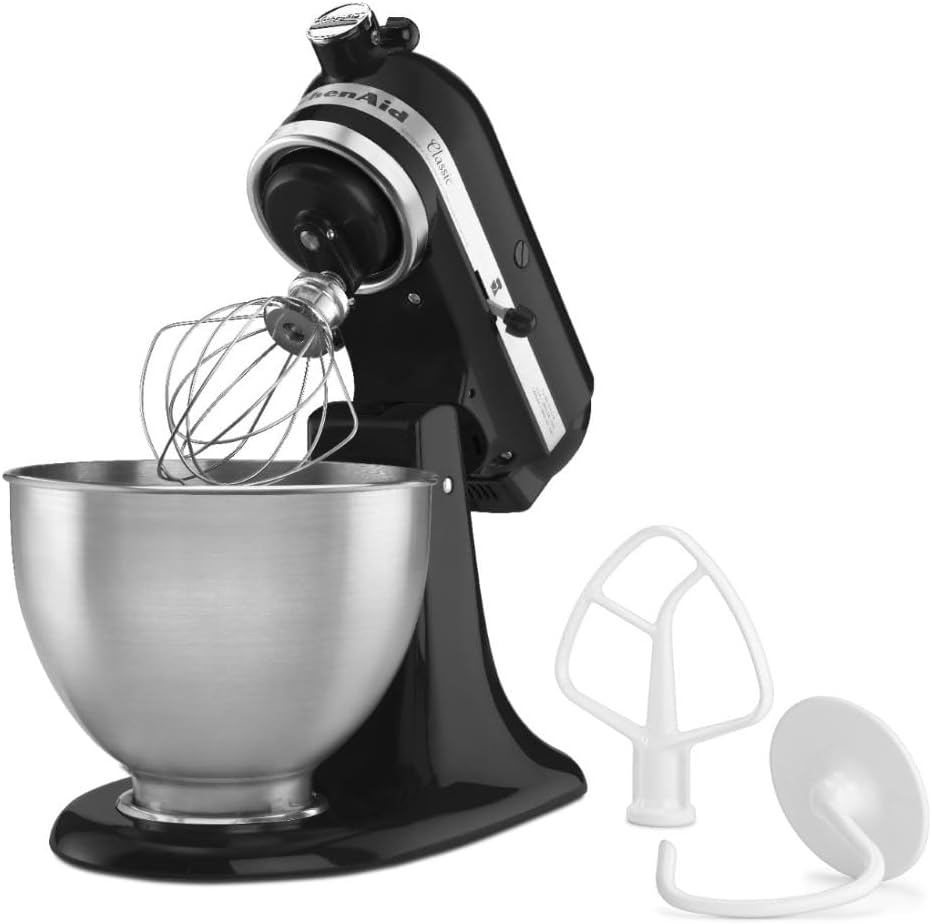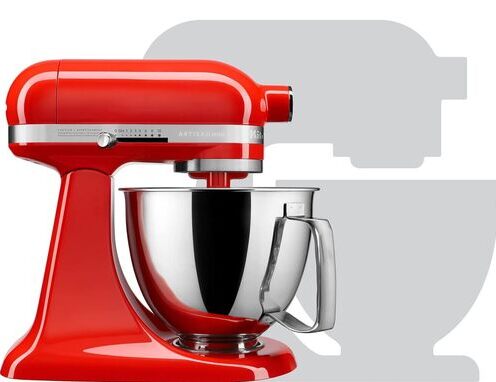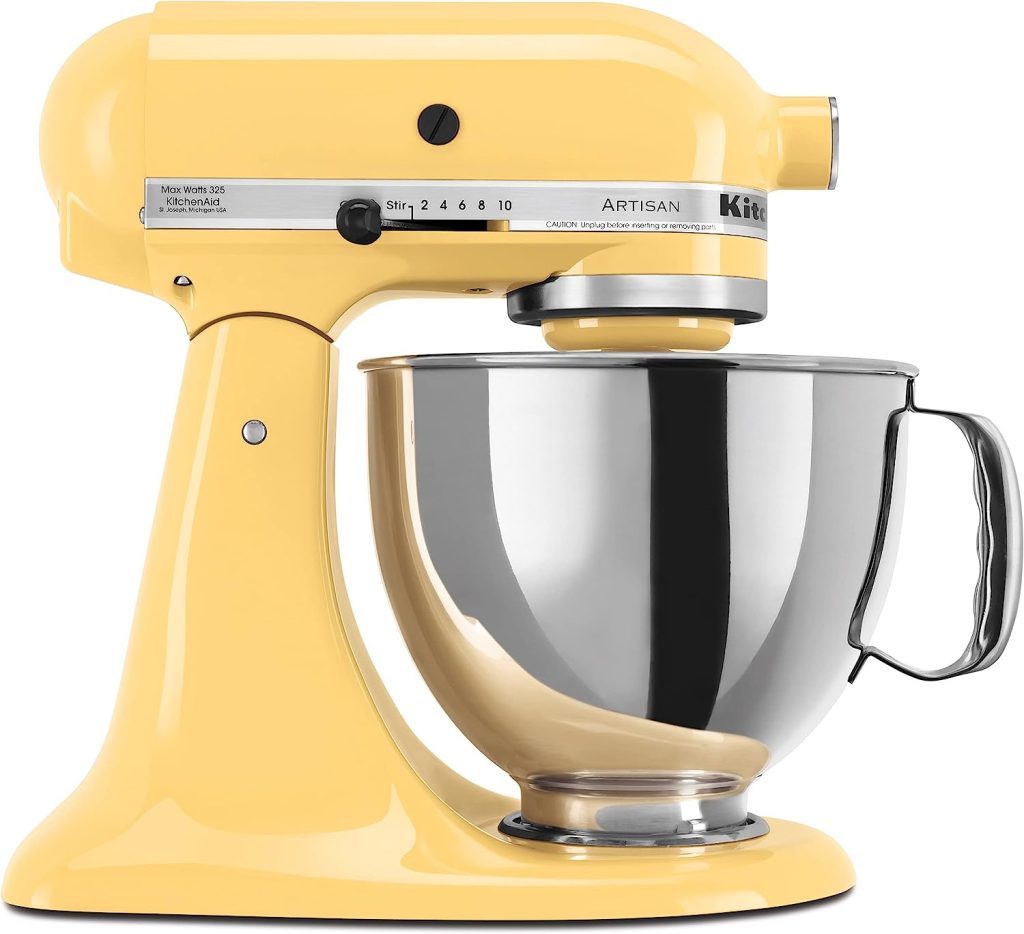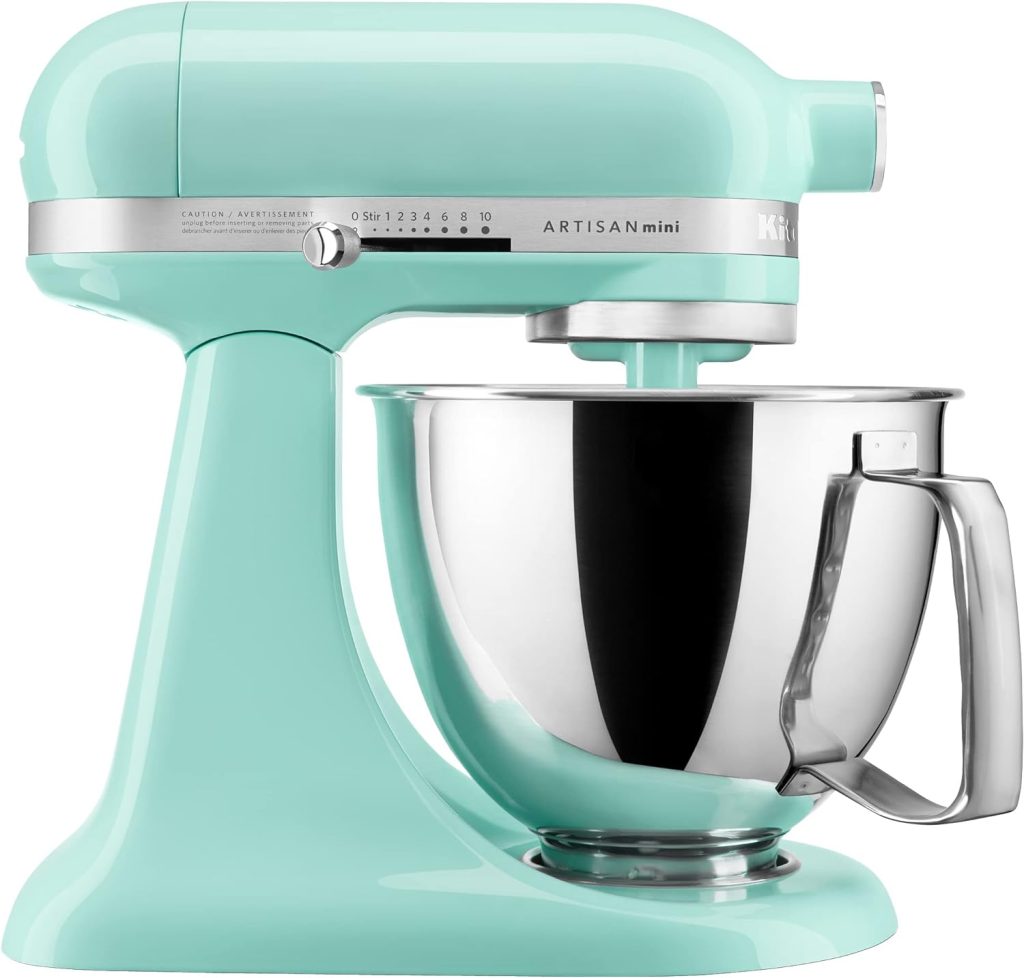Kitchenaid Mixer Classic vs Artisan review, which one is the best choice for you?
While there similarities between the two models, there are also some significant differences too. I’ll explain both similarities and differences in this review so you can decide which model will make the perfect addition to your kitchen.
By the end of this review, you’ll know such things as the motor sizes, the bowl sizes, what accessories you can get for each model, the different color options for each model, and how much each model costs. In short, you’ll know all you need to know to make your decision!
And, just so you know all your options, I’ve also included information about the Artisan mini. No point in leaving out the little sister!
Just a heads up: ZenQuestLife.com is a participant in the Amazon Services LLC Associates Program and other affiliate programs. That means that you should assume all links to products or services for sale are affiliate links. If you click on a link and make a purchase, you won’t pay one penny more but I may earn a commission.
Kitchenaid Background
The Kitchenaid stand mixer was patented in April 23, 1918. Originally called a “mixing machine” this powerful tool has helped bakers create delicious meals for over 100 years.
Some of the top chefs in the world swear by this fabulous machine (I do too, though I’m no top chef. Just ask my family!). I use it to make pizza dough for our homemade pizza night and it’s a life saver when making dozens upon dozens of Christmas cookies!
Even the famous Julia Childs had her own KitchenAid stand mixer. As a matter of fact, the actual kitchen she used, along with all the appliances and tools, is now a display in the Smithsonian Institution in Washington, D.C., including her KitchenAid mixer!
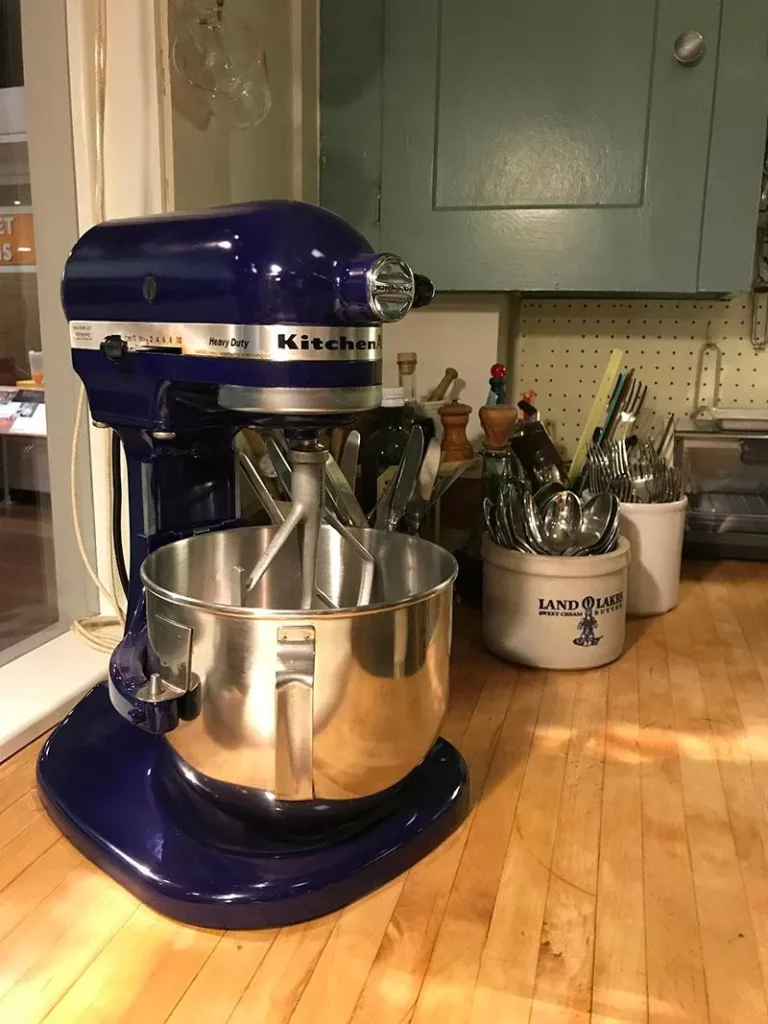
General Information for the Mixers, I’ll go into more detail below:
- Classic mixers have only a 4.5-quart capacity. Artisan models have a 5-quart and the smaller 3.5-quart Artisan Mini.
- A soft start feature is a feature o the Classic as well as the Artisan Mini mixers. This feature isn’t available on the bigger Artisan mixer.
- The Artisan mixing bowls come with a convenient handle, whereas Classic mixers don’t have this feature.
Classic mixer bowls rock a matte finish, while Artisan bowls have a glossy shine. - Artisan mixers come with a handy pouring shield that will stop splatters, a perk that Classic mixers don’t offer.
- When it comes to colors, the Artisan model has loads of color options, over 40, while Classic mixers keep it simple with only 3 color options – white, silver and black.
- Artisan mixers pack a punch with a 325-watt motor, while Classic mixers deliver a respectable 275-watt motor.
- You’ll typically find Artisan mixers to be about 35% pricier than their Classic counterparts. However, the Artisan Mini can be a budget-friendly choice if you’re looking for something smaller.
The Difference a Tilt-Head and a Bowl Lift Stand Mixer?
A tilt-head stand mixer has a head that tilts back for easy bowl access. This makes it easy to add ingredients and change accessories. The bowl-lift mixer works great for heavy mixtures and large batches. It has larger capacity, a sturdy base and a powerful motor.
Kitchenaid Mixer Classic vs Artisan Review: Let’s Get Started
Number of Models
The Classic model comes in just one size, but the whereas Artisan series give you more room to choose, with both the 5-quart and 3.5-quart Artisan Mini available.
Soft Start
Both the Classic and Artisan Mini mixers come equipped with a built-in soft start feature. This is a really nice feature that will keep your kitchen cleaner! No more flying cookie dough when you turn on your mixer. Unfortunately for your walls and cupboards, the 5-quart Artisan mixer doesn’t include this feature.
Size of Bowls
Even in the kitchen, size can matter! 😊 Classic mixers has a 4.5-quart bowl capacity, the Artisan has an even bigger 5-quart bowl and the baby of the family, The Artisan Mini, has a 3.5-quart bowl.
Handle on the Bowl
Artisan mixer bowls come with a convenient handle, making it easier to maneuver, pour, and handle your culinary creations. Classic mixers, however, don’t have this handle feature. It might sound like a small thing but having a handle can help when your hands are greasy. Don’t want to drop the whole thing on the floor like someone I know!
Bowl Finishes
It might sound geeky but I think these are niche looking machines. I love having mine displayed on my counter. So finishes and materials matter! The Classic come with matte finish bowls, and the Artisan bowls have a glossy shine. The choice here depends on your preference for aesthetics and ease of cleaning.
Which has a Pouring Shield?
Messy bakers, take note! Artisan mixers come with a handy pouring shield that helps keep those splatters at bay while you mix. Classic mixers, unfortunately, don’t include this accessory.
How Many Color Options?
When it comes to colors, Artisan mixers steal the show. With over 40 captivating color options to choose from, you can truly express your personality through your mixer. On the other hand, Classic mixers keep it simple with classic black, white, or silver.
Motor Power
Artisan mixers bring more muscle to the kitchen with a robust 325-watt motor, while Classic mixers offer a solid 275-watt motor.
Price
Now, let’s talk budget. Artisan mixers are generally about 35% pricier than Classic mixers. However, if you’re looking for a smaller option, the Artisan Mini can be a more budget-friendly choice.
Bottom Line: Which is Best For You – The KitchenAid Classic vs Artisan Mixer?
In the grand finale, the choice between the between the Classic, Artisan and Artisan Mini, really just boils down to your specific needs and preferences and budget. If you need that extra capacity, powerful performance, and want a lot of color choices, the Artisan mixer is your kitchen’s new best friend. However, if you’re content with a simpler color palette and don’t require the extra space, the Classic mixer offers excellent value for your dough-mixing needs.
So, whether you’re whipping up a batch of cookies, kneading bread dough, or exploring the world of culinary creativity, one of these KitchenAid mixers is bound to be the perfect companion for your culinary adventures. Check out the links below to explore Classic, Artisan, and Artisan Mini mixers further:
Classic Mixers – Amazon Click Here Walmart Click Here
Artisan Mixers – Amazon Click Here Walmart Click Here
Artisan Mini Mixers – Amazon Click Here Walmart Click Here
And now, to help you visualize the differences between the different models of KitchenAid stand mixers, here’s a handy comparison chart:
KitchenAid Classic vs. Artisan: Comparison Chart (and Artisan Mini!)
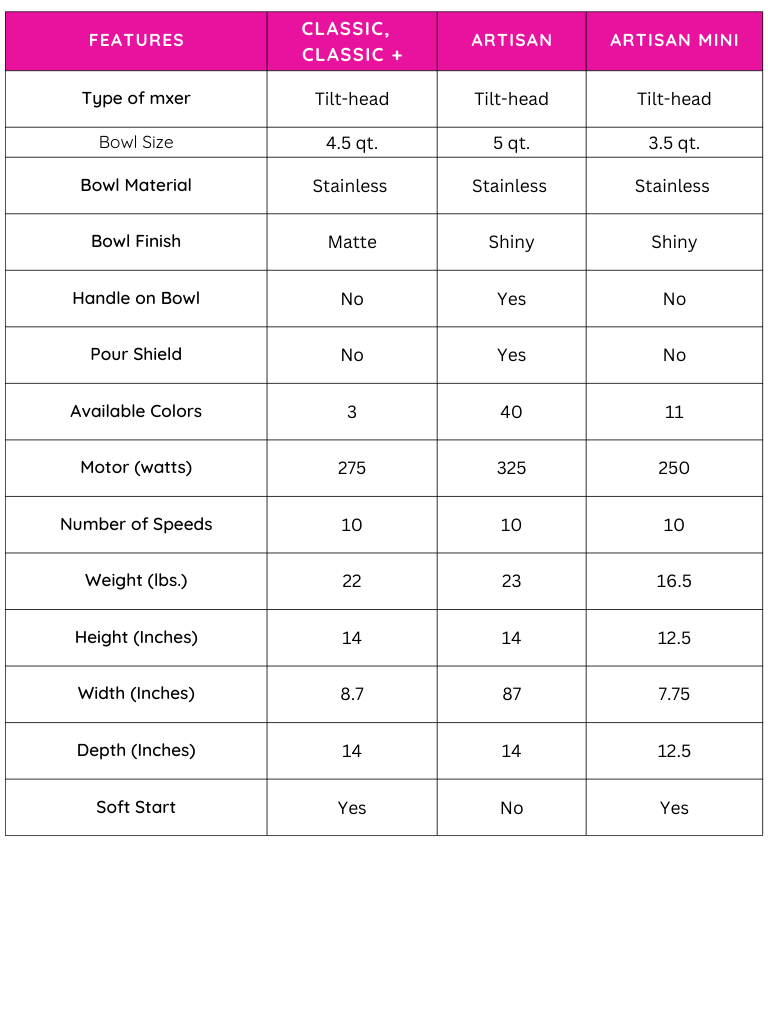
Are you ready to explore the common ground between KitchenAid’s Classic and Artisan mixers?
We’ve talked about the differences between them, now let’s talk about the features both have. The best features to make any of your baking tasks quicker and more enjoyable:
Tilt-Head Design
Both the Classic and the Artisan models of mixers sport a convenient tilt-head design. This means that the mixer’s head can be unlocked and tilts backward, that makes adding ingredients, scraping the bowl or even getting a little taste much easier!. It really is a very handy feature and can make everything easier.
The Available Attachments
The power hub is the same for the for the Classic and Artisan series. This is where you attach your accessories. Each model comes with a coated flat beater, a dough hook, and a 6-wire whisk. The Artisan goes the extra mile with a pouring shield, which helps keep your mixing mess in check.
Multiple Speeds
Both the Artisan model and the Classic come equipped with ten speeds, allowing you to fine-tune your mixing process. Whether you’re whipping up a delicate meringue or kneading a tough bread dough, these mixers have got you covered.
Size for Easy Storage
These mixers are designed with your kitchen in mind. They are both the same heigh and width, 14 inches and 8.7 inches respectively. They were made in these dimensions to ensure easy storage and so they would fit comfortably under your cabinets.
Easy Cleaning
The Artisan and Classic are designed to make cleanup quick and easy. The bowls as well as all the attachments can be put in the dishwasher which makes your cleanup much faster and easier. To clean the power hub just wipe it down with soapy, warm water and you’ll be good to go.
Materials Built to Last
Both the Classic and the Artisan series are made with durable zinc die castings, offering sturdiness and stability. Their relatively heavy weight keeps lessens vibrations and that keeps your mixer where it’s supposed to be while you’re using it. The mixer bowls are made of stainless steel. Some of the models have a smooth shiny finish on the bowls and others have a matte finish.
Proudly Made in the USA
It’s worth noting that KitchenAid mixers are still being manufactured in Greenville, Ohio, this is where they have been being produced since 1941. It’s a testament to their commitment to quality craftsmanship.
Now that we’ve explored what these mixers have in common let’s pivot to the exciting part: the differences that set them apart.
Differences Between KitchenAid Classic and Artisan Mixers
Different Models Available
When it comes to the Classic mixers, there are two different models: Classic and the Classic Plus. These models may appear distinct but, in reality, they are pretty much the same. The only real difference is the number of color options available between the two.
Classic Plus mixers are offered in silver or white, while the regular Classic mixers are available in white or black. Some sources may erroneously claim that the Classic Plus comes with a bigger, more powerful motor, but according to KitchenAid, both models share the same motor strength.
The Artisan series, on the other hand, offers more diversity. It includes a 5 quart size as well as the smaller Artisan Mini with a 31/2 quart size. It’s called a Mini for a reason, it is lighter weight, smaller size and less powerful than the Artisan. It is, however, also less expensive.
Size of Motor
Under the hood, the Artisan mixers flex their muscle with a robust 325-watt motor, providing a notable power boost over the Classic mixer’s 275-watt motor. The Artisan Mini has a smaller 250-watt motor, it is the smallest of all 3 with a smaller motor too.
The size of the motor only really comes into play if you’re making recipes with heavy batter. Things like bread, pizza dough and some type of cookie recipes will do better with a stronger motor. It really depends on the uses you have for your new stand mixer.
If you only occasionally make those heavier batter recipes, you can get by with the smaller motor. But, the motor will work harder which may ultimately affect the overall life span of your mixer. If you routinely mix heavier batters a bigger, more powerful motor, will make your baking easier and ensure a longer life for your mixer.
The Soft Start
This feature has probably saved many a kitchen mishap. How many times have you turned on your mixer and even at the lowest speed it starts going so fast that it ships batter, mashed potatoes or anything else you’re creating all over half your kitchen? Well, KichenAid has created the soft start which starts the mixer process slowly. This feature really does make you think these mixers were designed by knowledgeable chefs, doesn’t it? However, the 5-quart Artisan mixer skips this feature, whereas the Artisan Mini embraces it.
It does seem a little odd that one Artisan model would have the soft start and the other one doesn’t. Well, according to KitchenAid, this feature is a relatively new innovation. It wasn’t available when the Artisan mixers first hit the market. But, as of now, KitchenAid has no plans to update the design of the Artisan to include this feature.
Bowl Finishes
Let’s talk aesthetics and practicality. KitchenAid Classic mixers come with a sleek brushed stainless steel bowl. The matte finish is very classy and attractive, and better still, it hides, fingerprints and smudges. So when you clean it, it looks clean!
But, the KitchenAid Artisan mixers come with a bright, shiny stainless steel bowl. It can be a showstopper but it’s mirror like finish can be a hassle to keep ‘mirror like” in your kitchen.
And, if you want even more choices, KitchenAid does offer additional bowl options, which are available for separate purchase.
A Bowl Handle?
Here’s where the Artisan mixer series extends a helping hand. They come with an ergonomic, built-in handle that simplifies the process of detaching it from the base, scraping the bowl, and transporting it. This thoughtful addition enhances user-friendliness.
The bowl for the Classic model doesn’t have a handle. While this space-saving design choice has its merits, it may make maneuvering the bowl a tad more challenging.
The Bowl Size
Here’s how bowl size breaks down for each of the mixers: KitchenAid Classic mixers feature a 4.5-quart bowl, Artisan boasts a generous 5-quart bowl. The Artisan Mini offers a more compact 3.5-quart bowl. The choice depends on your culinary needs and the quantity of goodness you plan to whip up.
The Pouring Shield
Simple, but very practical, a pouring shield is just a clear plastic piece that fits snuggly around the lip of the mixing bowl. It prevents spills and splatters while mixing or adding ingredients.
While the Artisan series comes equipped with a pouring shield, the Classic mixer does not include this useful accessory. For many people, this simple feature might make the difference between this model and the Artisan.
Available Colors
The KitchenAid stand mixers are kitchen works of art. And like any artwork you want one that compliments your home.
Perhaps the most striking distinctions between the Classic and Artisan mixers is the sheer abundance of color choices available.
The Classic series keeps it simple, offering only three color options: black, white, and silver. Of course, these mor traditional and understated colors are perfect for some homes. Many like the classy elegance of these colors.
In stark contrast, the Artisan series invites you into a colorful wonderland with over 40 different shades to choose from. You can opt for timeless neutrals like white, cream, or silver, or embrace bolder color options.
Even the Artisan Mini mixers, though fewer in number compared to full sized Artisan, still offer 11 enticing hues. Keep in mind that the color palette frequently evolves, with new choices making their debut each year. No matter which color you prefer, with so many colors to choose from, you’re likely to find the perfect color.
Price
KitchenAid is recognized as the top brand of stand mixer available, and as such you will pay more for that reputation. Out of the 3 discussed in this article: The Classic, Artisan and Artisan Mini, the Artisan mixers are the highest priced options. They do have all the top features that make that price reasonable however. Again, it all comes down to your needs and your budget.
The other two models, the Classic and the Artisan Mini are a little easier on the wallet. Of course, that’s because they’re overall features are fewer too.
If you really want a KitchenAid stand mixer but your budget is a little tight, you may want to look at the certified refurbished models available. These units have seen light use but have been carefully restored to virtually new and usually come with a significantly lower price tag. Prices may vary among retailers, so it’s a good idea to look around to find the best mixer for the best price.
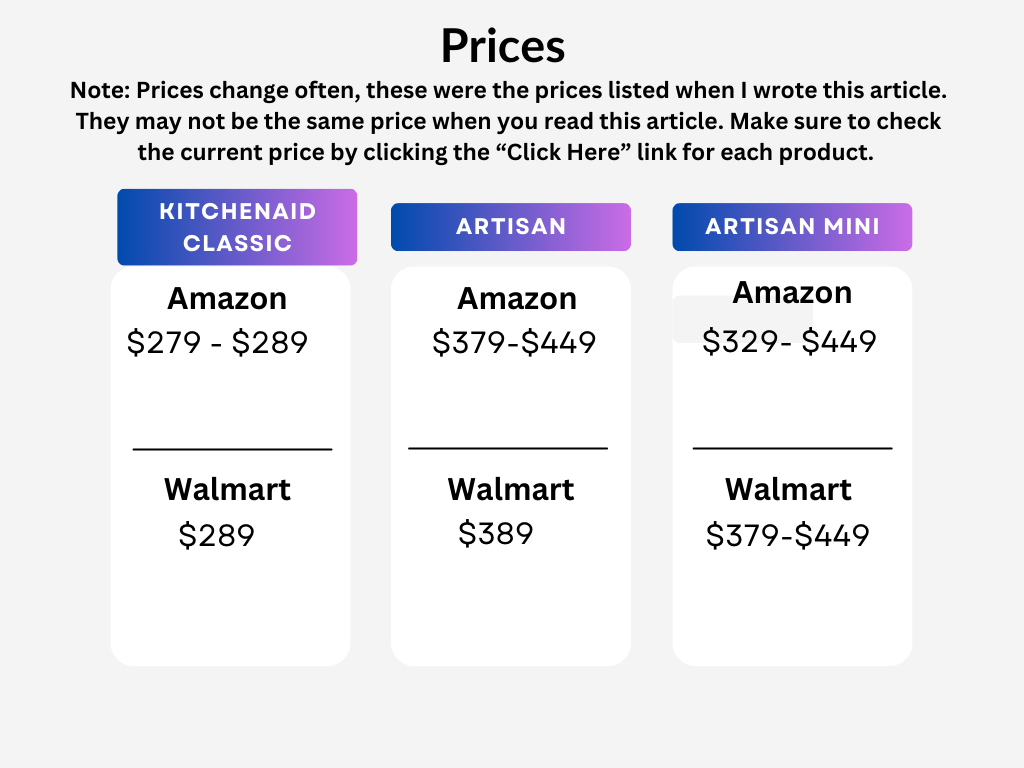
To explore the current prices of Classic, Artisan, and Artisan Mini mixers, check out the links below. Remember, prices change and prices for the same mixer in a different color may be different as well.
Classic Mixers – Amazon Click Here Walmart Click Here
Artisan Mixers – Amazon Click Here Walmart Click Here
Artisan Mini Mixers – Amazon Click Here Walmart Click Here
Bottom Line: Should You Buy a KitchenAid Classic or Artisan Mixer?
In the world of stand mixers, both the KitchenAid Classic, the KitchenAid Artisan and the KitchenAid Artisan Mini all offer compelling options, each with its own set of similarities and differences.
Recap of the features:
- The Classic comes in just one size, but the Artisan mixers come in two (5-quart and the 3.5-quart Artisan Mini).
- Artisan mixers do not have the soft start feature whereas the Artisan Mini and the Classic models do come with this feature.
- Artisan mixer bowls come with a convenient handle, while Classic mixers do not.
- The Classic model comes with a matter (non-shiny) stainless steel bowl. The Artisan series comes with polished, shiny bowls.
- Artisan mixers feature a pouring shield, while Classic mixers do not.
- The Artisan mixers have a ton of color options, over 40 colors. While Classic mixers offer a more limited color palette of black, white, and silver.
- Artisan mixers boast a more powerful 325-watt motor, compared to the 275-watt motor in Classic mixers.
- Artisan mixers typically come with a higher price tag. The Artisan mini, on the other hand, is the least expensive of the three.
The ultimate decision between the KitchenAid Classic and Artisan mixers depends on your specific needs and preferences. If you find yourself drawn to design extras, a more potent motor, and a larger bowl size, then the Artisan mixer might be the right choice for you.
On the other hand, if you prioritize a lower price point and don’t require the larger capacity, both the Classic mixer and the Artisan Mini are excellent options that will capably handle your mixing tasks.
I’m not really helping, am I? 🤷♀️🤔
The KitchenAid Warranty
The KitchenAid stand mixer comes with a standard one-year limited warranty. This warranty covers replacement of the mixer at no additional cost. Warranty information is found in the owners manual. In the USA, most KitchenAid stand mixers are covered by a one-year limited warranty that covers all 50 states, the District of Columbia, Puerto Rico, and Canada. The warranty for Australia, is a little longer, a domestic KitchenAid stand mixer will be covered under a 5-year warranty
If, during the first year of use, your KitchenAid mixer fails, KitchenAid will deliver either an identical, or a comparable model, directly to your home with no charge to you. They will also remove the old one.
In this scenario, the brand new mixer will also have the full one year warranty.
Even after the one year warranty, if you mixer fails after only a few years, you can contact KitchenAid. In some cases they may offer you a pro rated replacement.
Now, that you have all the pertinent information, you’ll be sure that you can make the best choice for your needs and budget. No worries about making the wrong choice, and honestly, these are all top mixers, I’m not sure there can be a bad choice. Click the links to make your purchase if you’re ready, or just do a little window shopping!
Classic Mixers – Amazon Click Here Walmart Click Here
Artisan Mixers – Amazon Click Here Walmart Click Here
Artisan Mini Mixers – Amazon Click Here Walmart Click Here
